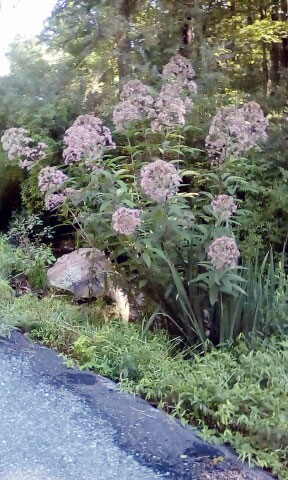by Christine Maccabee
Tall Beauties and Late Bloomers
Where I live in upper Frederick County, I get to enjoy the various flowering plants blooming on our roadsides, truly making rides in our cars “scenic,” as many signs say along the roads. For me, it is not just the wonderful wide open landscapes of fertile farmlands and ancient mountains that make it scenic; it is the various wildflowers that bloom at their own pace, in their own time, some in early summer and others in late summer. Unfortunately, most are mowed down before they can bloom.
It is hard to believe we are in late summer with autumn soon to come. Meanwhile, the late-blooming Joe Pye weed and wild evening primrose are blooming here and there, attracting butterflies and bees with their wonderful, essential nectar and pollen. Just today, I saw some of these tall beauties along Hampton Valley Road, very near the Eyler Valley Chapel. It takes a discerning, and interested, eye to see them and appreciate them for what they are. They are mostly misunderstood and underappreciated, much like human late bloomers.
Being a late bloomer myself, I learned to love all the natural plants and animals around me at a young age. There wasn’t a day I did not go out exploring and observing. I was not a popular girl like many others. I was similar to wild plants, taking a long time to grow and bloom. Years later, at a class reunion, my neighbor, Bobby, told me that he and the other boys had admired me for my interest in turtles. I had a Turtle Town, as I called it, composed mostly of box turtles and some mud turtles. His words surprised me. If only I’d known the boys admired me back when…if only…
Unfortunately, over the years, I have seen so many wild places destroyed, it makes my head spin. Healthy habitat for wildflowers, which bloom all the way until frost, is essential for our pollinators. So, when I see these wildfloweers cut down before they even get a chance to grow a foot tall, I get depressed. Many people get cut down before they have a real chance to bloom, too. However, humans, as well as plants, are resilient. In between the cracks, we somehow continue to flourish. The mowers cannot always reach beyond the ditch, so the wildflowers can flourish there. And, thankfully, there are also some caring people who nurture and appreciate us and keep us around!
Joe Pye weed and evening primrose will soon fade away for another year, another whole year! I will miss them, as will the bees and butterflies.
However, soon to come, and right on their heels, are the really late bloomers: the goldend rods and wild asters. In this area, there are several varieties of wild aster that I know of: the white wood aster, the panicled aster, small-flowered white aster, and the purple Canadian aster. Of the 16 varieties of goldenrods throughout North America, we have around 4 in Frederick County: the lance-leaved goldenrod, tall goldenrods, stiff goldenrods, and rough-stemmed goldenrods. I’m using the common names, not scientific names, as they are descriptive. I recommend getting a good identification book such as the Audubon Society Field Guide to North American Wildflowers for greater understanding of these, and other, important wild plants.
Did you know that the pollen of goldenrods is not the major allergy problem? Their pollen is too heavy to travel far. It is ragweed pollen that creates problems for people, with its inconspicuous blooms that develop at the same time as goldenrod. However, in the wild, ragweed seeds have oils that help wild birds survive throughout the fall and winter.
Everything has a purpose, even you and me. Let’s make sure we all honor one another during the trying days ahead. We need to appreciate the diversity of all living entities and their contribution to the health and wholeness of life on our precious planet, Earth, of which we are all caretakers.

Late-blooming Joe Pye “weed” along Hampton Valley Road.

Another tall beauty, late-bloomer: wild evening primrose in Christine’s garden.

